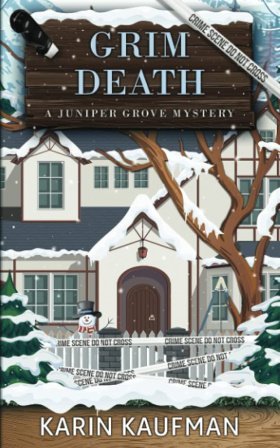“No,” Gilroy answered.
“Remember the last time someone used a crowbar to break into this house?”
“Thanksgiving before last,” he said. “Like I said, we’re getting an alarm system.”
After Turner left, Gilroy jiggled the door shut, and the furnace began to catch up on the heat. Then Gilroy called in a favor—he was owed many and seldom collected—and a locksmith who was also handy at door frame repairs said he’d be at the house in an hour.
We ate lunch in the kitchen and I filled Gilroy in on the latest: Dalton’s habit of purchasing gossip for his paintings and the mega-bucks he spent on his home and land—he’d already heard about the contractors—Mary’s lies, and Charlotte searching the Records Section to see if Laura Patchett had applied for assistance.
Feeling pretty satisfied with myself, I asked what he’d been up to.
“When you called the station I was at the Taylor crime scene. One of the contractors did some drywall work last summer and found two wired listening devices, one behind a light switch and another behind a baseboard.”
I almost dropped my creampuff.
“He told Taylor, and on his instructions he tore them out.”
“Someone was spying on him, and he knew. Did the contractor have any idea when the devices were installed?”
“He’d seen audio bugs before and said these looked up to date, that’s it. They were wired for power, but he didn’t know how they transmitted. Wifi probably, but it’s impossible to tell now. If Taylor kept the devices, we haven’t found them yet, and we got nothing when we searched for other devices.”
“Dalton moved into that house about a year ago.”
“Yes. Underhill’s going to go over the place again, especially the studio.”
“The home’s previous owner didn’t put those bugs in.”
“Doubtful.”
“You know Isak wired the studio for sound?”
“Yes, soon after Taylor moved in.”
“And we know Shasta had an affair with Dalton.”
“We do.”
Gilroy took his dishes to the sink, one of those wheels-turning expressions on his face.
Lie after lie, gossip, backstabbing, and now a stolen painting. The second stolen painting.
“Why would someone steal your landscape?” Gilroy asked. He was holding a K-cup and leaning against the counter, poised to make another cup of caffeine.
“Money, I guess. Dalton paid for gossip so he could paint it and sell it. For him, it was kicks. Brodie digs for gossip to publish in the Post, making himself valuable to the owner. Mary guarantees her job by finding and airing dirty laundry. Charlotte snoops to gain Brodie’s attention, and maybe to make money on the side.”
Gilroy was shaking his head. “If the intruder wants money, why didn’t he steal the other paintings from Taylor’s studio? They’re still there. As far as we know, only two paintings are missing—yours and the one that was covered with a drop cloth.”
“And we don’t know what the covered one was. Was it a landscape? Another Hidden Little Town painting?”
Gilroy set the K-cup on the counter and grabbed his coat. “Gotta run. I have an interview with Shasta Karlsen at the station, one-thirty. I need to get Isak in, too. Can you wait for the locksmith?”
“Sure.”
“He’ll be here in ten minutes. David Symons.”
“I know what he looks like.”
He drew me into a hug and I slipped my arms through his open coat and wrapped them around his waist, holding him tightly. I wanted to stand there forever, feeling the warmth of his body against mine. He made me feel cherished and safe, and I told him so. After all, we were still newlyweds.
“Be careful,” he said quietly. “This murderer, man or woman, has nothing to lose. I know you love clues and puzzles, but it’s not a game.”
“I know that, James.”
“Though you are good at puzzles.”
“Thanks.”
“Don’t trust anyone.”
“Except David Symons?”
“Except David Symons.”
CHAPTER 16

Charlotte Wynn may have gotten Laura Patchett killed.

























